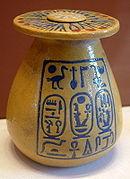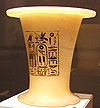.gif)
Bread-cone (hieroglyph)
Encyclopedia
The ancient Egyptian
Bread Cone is one of the oldest language
hieroglyphs from Ancient Egypt. It was used in the early dynasties of Egypt, with usage at the time of the Pyramid Texts
. The meaning of the Bread Cone is: "to give", "present".

Since the concept "to give" is of common usage in human society, more than one word fulfilled this for the Ancient Egyptians. The usage of the Bread-cone in language is "di", to give, present. It became formulaic; for example: the pharaoh, "given-(bread-cone), Ankh-life
, Endurance-(Djed
), forever, like Ra
".
. It is commonly found in the last line before an individual's name, but is used throughout texts: for example, gods are often referenced as giving items, accomplishments, gifts, products of the country, to the individual of whom it is being written.
 Pharaoh Pepi I, (reign 2332-2283 BC) celebrated his first Sed festival
Pharaoh Pepi I, (reign 2332-2283 BC) celebrated his first Sed festival
about 2302 BC, with a rather ornate alabaster
vessel made by drilling the object's core with the ancient Egyptian hand drill
. The object has hieroglyphic
text in three vertical columns; also a horizontal text below the three, read from center, both leftwards and right.
The left column is read left as one column and is the Pharaoh's 'serekh name'. Column center, (Nebty name
), and right are read as columns 2, then 1 and column 1 exclaims his sed festival: "first occurrence, S-d festival" (with 3 festival determinative
hieroglyphs-Pavilion
, Hall, and Festival).
The line of text below with the Bread-cone used twice for reading both left-and-right, (and 'Kingship' for "usr"-(power)), "Given 'Living-Kingship' Forever"-(di-ankh-usr-djet). (see also the phrase: "Long Live the King")
Ancient Egypt
Ancient Egypt was an ancient civilization of Northeastern Africa, concentrated along the lower reaches of the Nile River in what is now the modern country of Egypt. Egyptian civilization coalesced around 3150 BC with the political unification of Upper and Lower Egypt under the first pharaoh...
Bread Cone is one of the oldest language
Egyptian language
Egyptian is the oldest known indigenous language of Egypt and a branch of the Afroasiatic language family. Written records of the Egyptian language have been dated from about 3400 BC, making it one of the oldest recorded languages known. Egyptian was spoken until the late 17th century AD in the...
hieroglyphs from Ancient Egypt. It was used in the early dynasties of Egypt, with usage at the time of the Pyramid Texts
Pyramid Texts
The Pyramid Texts are a collection of ancient Egyptian religious texts from the time of the Old Kingdom. The pyramid texts are possibly the oldest known religious texts in the world. Written in Old Egyptian, the pyramid texts were carved on the walls and sarcophagi of the pyramids at Saqqara during...
. The meaning of the Bread Cone is: "to give", "present".
Language usage: other words of "to give"

Since the concept "to give" is of common usage in human society, more than one word fulfilled this for the Ancient Egyptians. The usage of the Bread-cone in language is "di", to give, present. It became formulaic; for example: the pharaoh, "given-(bread-cone), Ankh-life
Ankh
The ankh , also known as key of life, the key of the Nile or crux ansata, was the ancient Egyptian hieroglyphic character that read "eternal life", a triliteral sign for the consonants ʻ-n-ḫ...
, Endurance-(Djed
Djed
The djed symbol is a pillar-like ancient Egyptian symbol representing stability. It has been interpreted as the backbone of the Egyptian god Osiris, especially in the form Banebdjedet . Djedu is the Egyptian name for Busiris, a centre of the cult of Osiris...
), forever, like Ra
Ra
Ra is the ancient Egyptian sun god. By the Fifth Dynasty he had become a major deity in ancient Egyptian religion, identified primarily with the mid-day sun...
".
Iconographic usage of Bread-cone
Since the usage of the Bread-cone was also formulaic, it often appeared in Ancient Egyptian hieroglyphic iconographyIconography
Iconography is the branch of art history which studies the identification, description, and the interpretation of the content of images. The word iconography literally means "image writing", and comes from the Greek "image" and "to write". A secondary meaning is the painting of icons in the...
. It is commonly found in the last line before an individual's name, but is used throughout texts: for example, gods are often referenced as giving items, accomplishments, gifts, products of the country, to the individual of whom it is being written.
Vessel for Pepi I's Sed festival

Sed festival
The Sed festival was an ancient Egyptian ceremony that celebrated the continued rule of a pharaoh...
about 2302 BC, with a rather ornate alabaster
Alabaster
Alabaster is a name applied to varieties of two distinct minerals, when used as a material: gypsum and calcite . The former is the alabaster of the present day; generally, the latter is the alabaster of the ancients...
vessel made by drilling the object's core with the ancient Egyptian hand drill
Hand drill (hieroglyph)
A Hand drill is a hieroglyph, , used in Ancient Egypt from the earliest dynasties. As a hieroglyph, it can also be used as a determinative for words related to the profession of vase, bowl, pot-making, etc., typically from fine-grained, colorful rare stone, for example unguent jars...
. The object has hieroglyphic
Egyptian hieroglyphs
Egyptian hieroglyphs were a formal writing system used by the ancient Egyptians that combined logographic and alphabetic elements. Egyptians used cursive hieroglyphs for religious literature on papyrus and wood...
text in three vertical columns; also a horizontal text below the three, read from center, both leftwards and right.
The left column is read left as one column and is the Pharaoh's 'serekh name'. Column center, (Nebty name
Two Ladies
In Ancient Egyptian texts, Two Ladies is a religious euphemism for Wadjet and Nekhbet, the deities who were the patrons of the Ancient Egyptians and worshiped by all after the unification of its two parts, Lower Egypt, and Upper Egypt...
), and right are read as columns 2, then 1 and column 1 exclaims his sed festival: "first occurrence, S-d festival" (with 3 festival determinative
Determinative
A determinative, also known as a taxogram or semagram, is an ideogram used to mark semantic categories of words in logographic scripts which helps to disambiguate interpretation. They have no direct counterpart in spoken language, though they may derive historically from glyphs for real words, and...
hieroglyphs-Pavilion
Jubilee Pavilion (hieroglyph)
The Jubilee Festival for the Pharaoh, the Heb Sed is represented in hieroglyphs by a Jubilee Pavilion Hieroglyph. It is Gardiner Sign Listed as no. O23. However it often appears with other pavilion, or festival hieroglyphs: the Hall, no. O22, O22 and an alabaster Basin, no. W3...
, Hall, and Festival).
The line of text below with the Bread-cone used twice for reading both left-and-right, (and 'Kingship' for "usr"-(power)), "Given 'Living-Kingship' Forever"-(di-ankh-usr-djet). (see also the phrase: "Long Live the King")
See also
- Gardiner's Sign List#X. Loaves and Cakes

